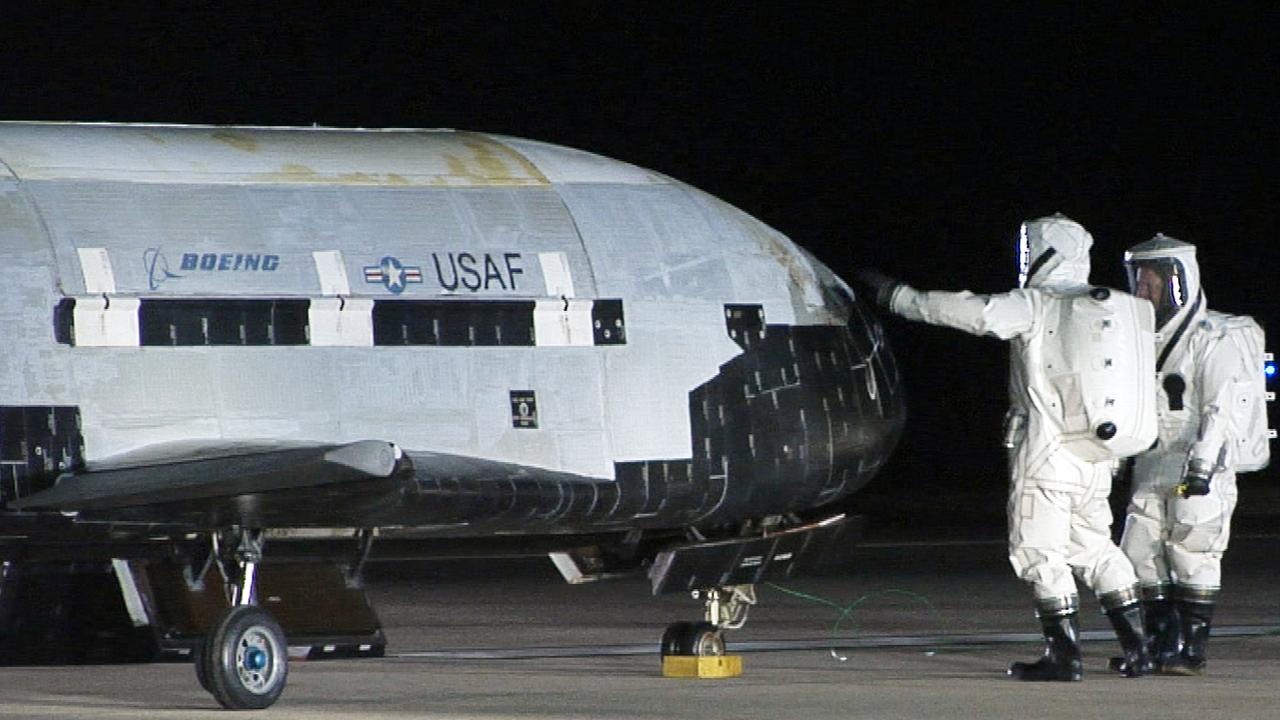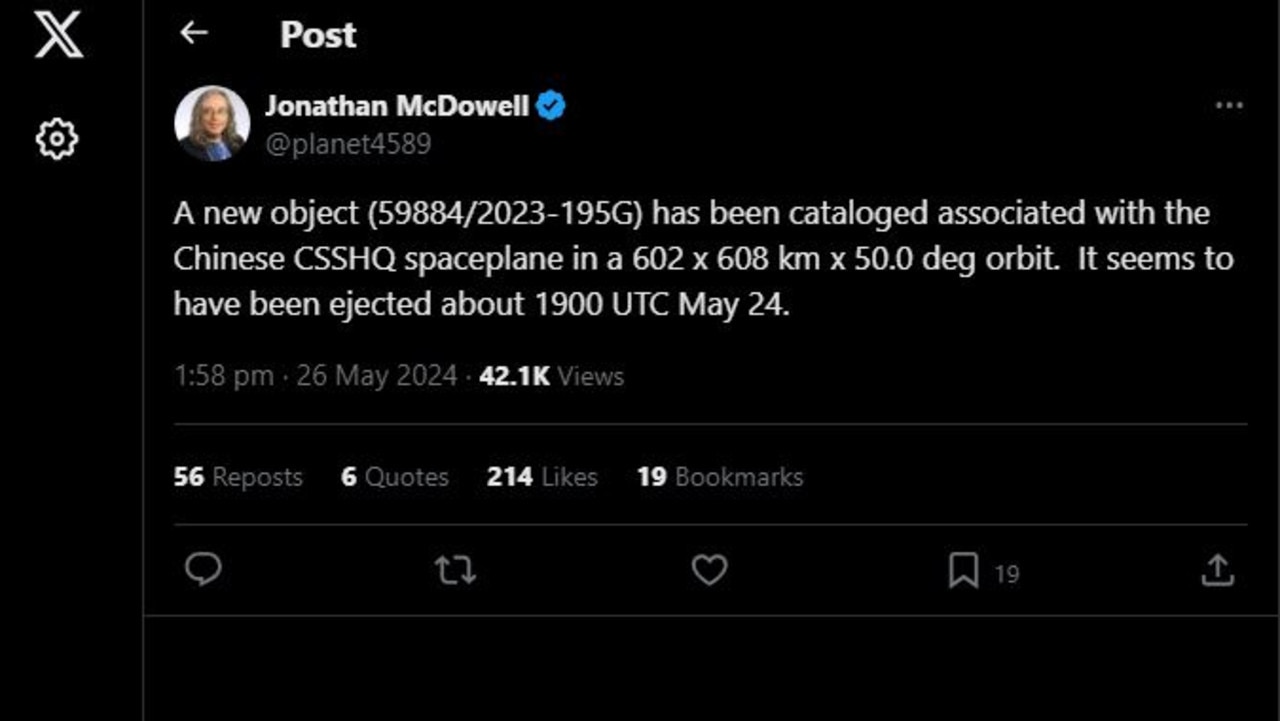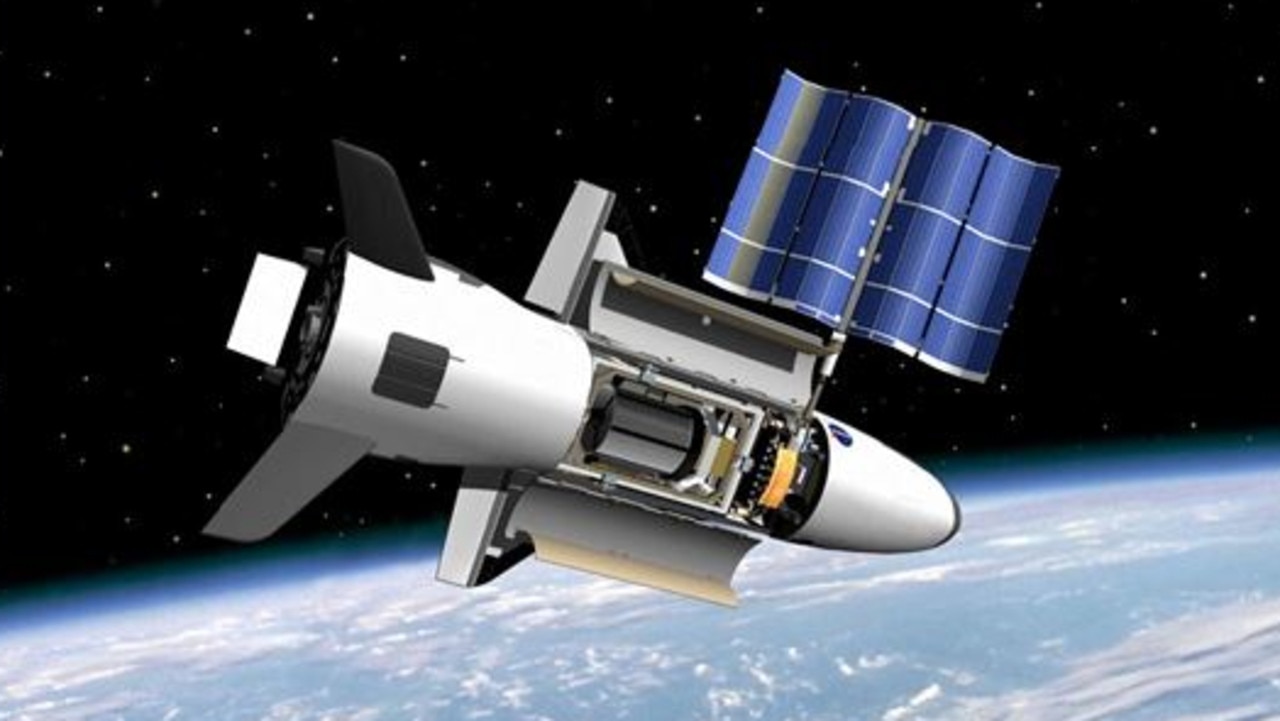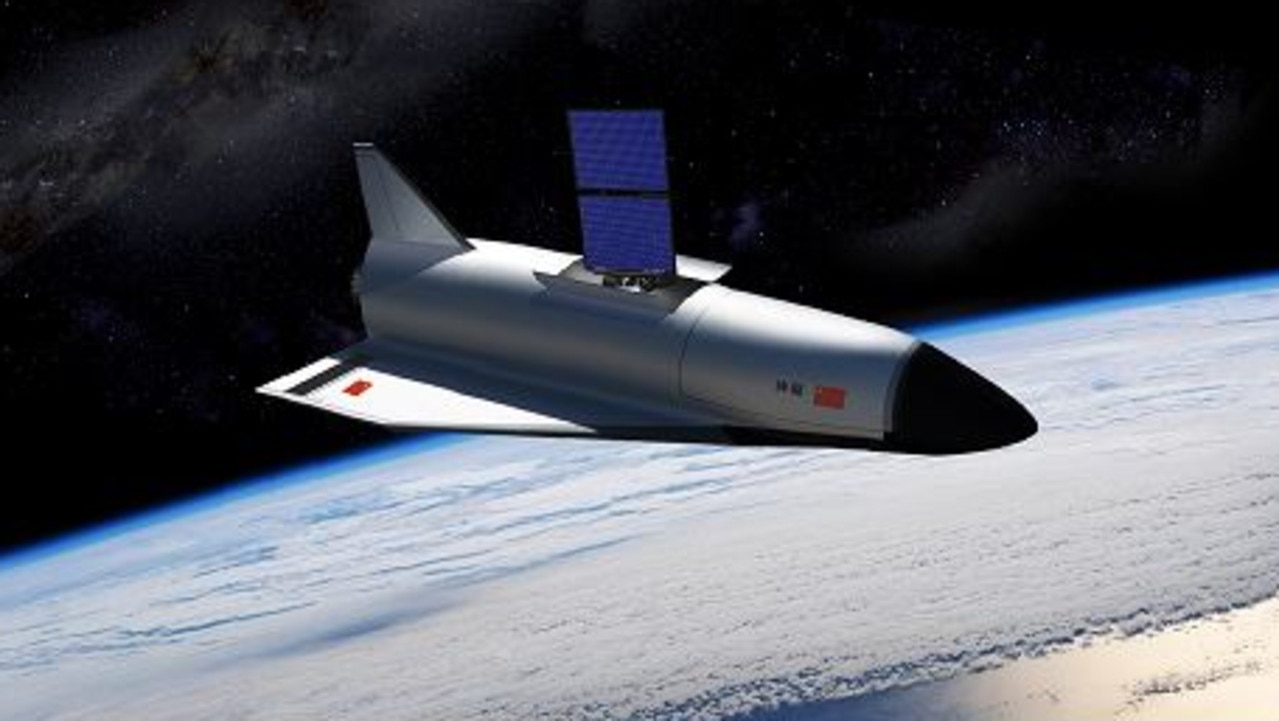Secret Chinese ‘space plane’ sparks fears of an space war
The mysterious behaviour of a secret Chinese ‘space plane’ has the world increasingly worried that Earth’s orbit is on the brink of becoming a battlefield.
We don’t know what it looks like. We don’t know what it’s doing. But the mysterious behaviour of a secret Chinese ‘space plane’ has the world increasingly worried that Earth’s orbit is on the brink of becoming a battlefield.
International space-tracking organisations, once the exclusive domain of national governments, are giving us a peek at what’s happening above our heads.
A potentially deadly game of cat and mouse is escalating among the orbiting internet and communications relays, mapping cameras, climate monitors – and junk.
It’s getting crowded up there.
SpaceX’s Starlink satellite constellation alone has added more than 5800 orbital objects in the past decade.
Recent estimates put the number of ‘active’ satellites at 9900.

An even greater number of ‘dead’ satellites are still lingering up there, many of them will likely remain for centuries, along with the remnants of rocket bodies and expended engines.
Gone are the days of simply slinging an ultra-expensive piece of machinery into orbit and hoping for the best.
Most are now being fitted with tiny, ultra-efficient thrusters. This is to separate them from the crowd after being offloaded from a delivery ‘truck’, like a SpaceX Falcon Heavy.
They allow satellites to select their individually desired orbits. And they’re helping dodge the debris increasingly clogging the orbital space lanes – not to mention legitimate traffic.
But some carry bigger thrusters and more fuel. We don’t know what else.
They’re jumping orbital lanes.
They’re tailgating sensitive pieces of commercial and military hardware.
They could be eavesdropping, they could be observing; they could be interfering.
They also could be practising to destroy critical pieces of infrastructure once the order is given.
Chief among them are the sleek, reusable shuttle-like space planes of the United States and China.
The US launched its seventh Boeing X-37B mission on December 28 last year, with its activities a closely guarded secret.

China put its own ‘Shenlong’ (Divine Dragon) up for the third time just two weeks earlier, which has just been observed releasing an unidentified object into orbit.
Unusual activities
“This object could be a sub-satellite deployment, or it could be a piece of hardware ejected prior to end of mission and deorbit,” says Dr Jonathan McDowell of the Harvard-Smithsonian Center for Astrophysics.
“The space plane’s first flight did something similar. Will be interesting to see if the plane manoeuvres or lands soon.”
It’s not the first time this space plane has been seen deploying cargo. It released six objects shortly after launch late last year, which were observed to be transmitting signals before apparently being recovered.

“It will carry out reusable technology verification and space science experiments as planned, providing technical support for the peaceful use of space,” reads a statement released by China’s state-controlled Xinhua news agency at the time of the space plane’s launch.
China’s first space plane mission, in 2020, lasted little more than two days. It’s second went for 276.
Objects were observed separating from the craft, and staying in orbit, shortly before both landed.
This is odd as, under international convention, satellite deployments are generally announced for traffic control purposes – even if their exact nature and role aren’t revealed.
But odd behaviour in space is giving global defence forces the jitters.

And the US Space Force, instituted under President Donald Trump in 2019, is keen to talk about the threat space conflict represents.
“I have got to counter that threat to ensure that the space capabilities that we have come to depend on for our way of life will be there well into the future,” said its commanding officer, General Chance Saltzman.
It won’t talk about its own orbital weapon systems outside generalities.
“We have a variety of capabilities we can bring to bear and we’ll continue to develop capabilities that allow us to maintain a credible deterrence posture,” Space Force Brigadier General Jesse Morehouse told a briefing in London last week.
But the Space Force is happy to highlight Russian and Chinese space-based threats.
“China, for example, has a new sensor-shooter kill web that creates an unacceptable risk to our forward deployed forces and allies, particularly here in the Pacific,” General Saltzman told an Australian audience earlier this month.
And then there’s the growing risk of treaty-defying anti-satellite missiles and “killer” satellites.

The nuclear option
“With just a handful of destructive events, there can be a significant impact on missions performed by satellites,” says Saltzman.
“The outsize benefits of attack invite a pre-emptive first strike on orbit.”
The best way to mitigate this risk, he says, is to replace dozens of satellites with thousands.
“This would significantly raise the level of destruction needed to deny any mission space, the attack calculus changes and the benefits of a first strike are negated,” he explains.
Morehouse later added on to say Ukraine’s use of the SpaceX Starlink internet satellite service had proven this principle.
“It makes no sense for Russia to even try to shoot one down because there’s thousands of them, and they don’t have thousands of anti-satellite missiles,” Morehouse explained.
But Russia is being accused of potentially launching a deadly new kind of “killer” satellite.
Kosmos-2576 was launched on May 16 into the same orbital plane (angle, not height) as USA 314, a US military reconnaissance satellite believed linked with nuclear warning command NORAD.
US Pentagon spokesman Major General Pat Ryder told a media briefing Russia had “launched a satellite into low-Earth orbit that we assess is likely a counter-space weapon, presumably capable of attacking other satellites in low-Earth orbit.”
So far, Kosmos-2576 has been observed behaving similarly to other Russian “inspector” satellites. It’s likely to adjust its orbit to close with USA 314 as similar “inspectors” have done to other targets in the past.

The US, however, insists this one has been weaponised.
Moscow has demonstrated it has satellites that can fire “projectiles” while in orbit, but it has also threatened to use a nuclear device.
Such a warhead doesn’t need to hit an individual space target.
The radiation flash produced by an explosion would disable any satellite within line of sight. However, Earth’s magnetic fields will also trap the radiation in space. This cloud could linger in orbit for months, killing any surviving satellites that pass through it.
Russia last month vetoed a UN Security Council reaffirmation of the 1967 Outer Space Treaty, which prohibited the deployment of weapons in orbit. This resolution called explicitly on nations not to develop electromagnetic pulse-generating nuclear anti-satellite weapons.
“The United States assesses that Russia is developing a new satellite carrying a nuclear device,” US National Security Adviser Jake Sullivan declared.
“We have heard President Putin say publicly that Russia has no intention of deploying nuclear weapons in space. If that were the case, Russia would not have vetoed this resolution.”
Jamie Seidel is a freelance writer | @JamieSeidel






